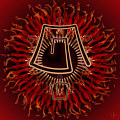|


© Janet Preslar |
British Culture... A BRIEF History |
Children's Literature has evolved over the years in response to the world's changing ideas about children and childhood.
In the Beginning
Prior to the 1600's, children were not given their own literature.Most storeis and news were carried by spoken word by minstrels and bards who strolled from town to town, and regional differences in common tales can be seen today. It wasn't until later that these stories became codified when some printers began to publish them in hard copy. Change Begins
Most of society's literature was designed for entertainment, not designed for education or instruction. The entertainment side began to make itself evident when William Caxton, an English printer, began to publish stories from the oral tradition. Caxton was a very important figure in children's literature, translating not only the familiar stories from France contributed to Perrault, but also the first English versions of Aesop's Fables. Middle-Class Life
With the rise of a middle class, especially in England, a new type of literature for children was created, published and distributed specifically for both the education and entertainment of children. The most prominent of these was John Newberry, who created pocketbooks in the mid-1700s that included some Mother Goose, some folk rhymes, including a little Shakespeare, as well as the retelling of standard tales from culture. In France, Rousseau presented a view exactly opposite to that of the Puritans... he proposed that children were a blank slate... a purity that was tainted by living in the world. His proposal was that children under the age of 12 word not to read any material, but were rather to experience the world with a chaperone of sorts whose purpose was merely to explain, but not direct. In other words, the adult was there for consultation, but all of the decisions as to what the child was to do were left up to the child. From this, a series of books that remain popular well into the 20th century arose in which simple stories, usually focusing on two specific characters, one good and one bad, presented the reader with the various options for action and reaction a person might take, as well as the consequences thereof. Very often, thee BAD character was shown the light and modified his behavior by the end of the story. However, the material was not so direct as to make a specific didactic statement, but rather to show by example how one could be successful and happy in the world.
A New View
From this came the SUNDAY SCHOOL MOVEMENT begun in 1780 which is essentially was a series of stories written for poverty-stricken children to instruct them as to how to live a moral life. However, with the Romantic movement and the rising Victorian middle class came the new view of the child... it was a belief and understanding that children had a world of their own, as equally complex and demanding as that of the adult world, but clearly separate from the adult world. It was a notion that childhood was a time of innocence that was to be nurtured and reflected in a special kind of literature that is still popular in the 21st century. The material from the Brothers Grimm and material from Hans Christian Andersen were translated into English, and others created new material specifically designed for the sensibilities of children that focused on a child's imagination and creativity. By the mid-1800s there were children's fantasy books, including the poetry and prose written by Lewis Carroll, .....The characters were realistic, the plots interesting and exciting, and the material was obviously written for the juvenile reader. There was no overt moral message in the material, as much as the reflection of the attitudes and perspectives of children. Children's literature subdivided into various categories that mimicked that of standard literature written for adults... adventure, drama, fantasy, humor and even romance.
The 1900's
By the mid 20th century, children's literature was in full swing. Characters and plots were fleshed out, well developed and clearly designed for a very specific audience. This material included Mary Poppins, The Chronicles of Narnia and Charlotte's Web. This comprised the first Golden Age of children's literature. Today, works such as the Harry Potter series reflect both the long history of Britain and much of its cultural mythology.
Works Cited
Saltman, Judith. Trade and Plumbcake Forever. The Riverside Anthology of Children's Literature, 6th ed.
Houghton Mifflin, 1985.
© T. T. Eiland, August, 2006
Last modified: August 5, 2006
|
